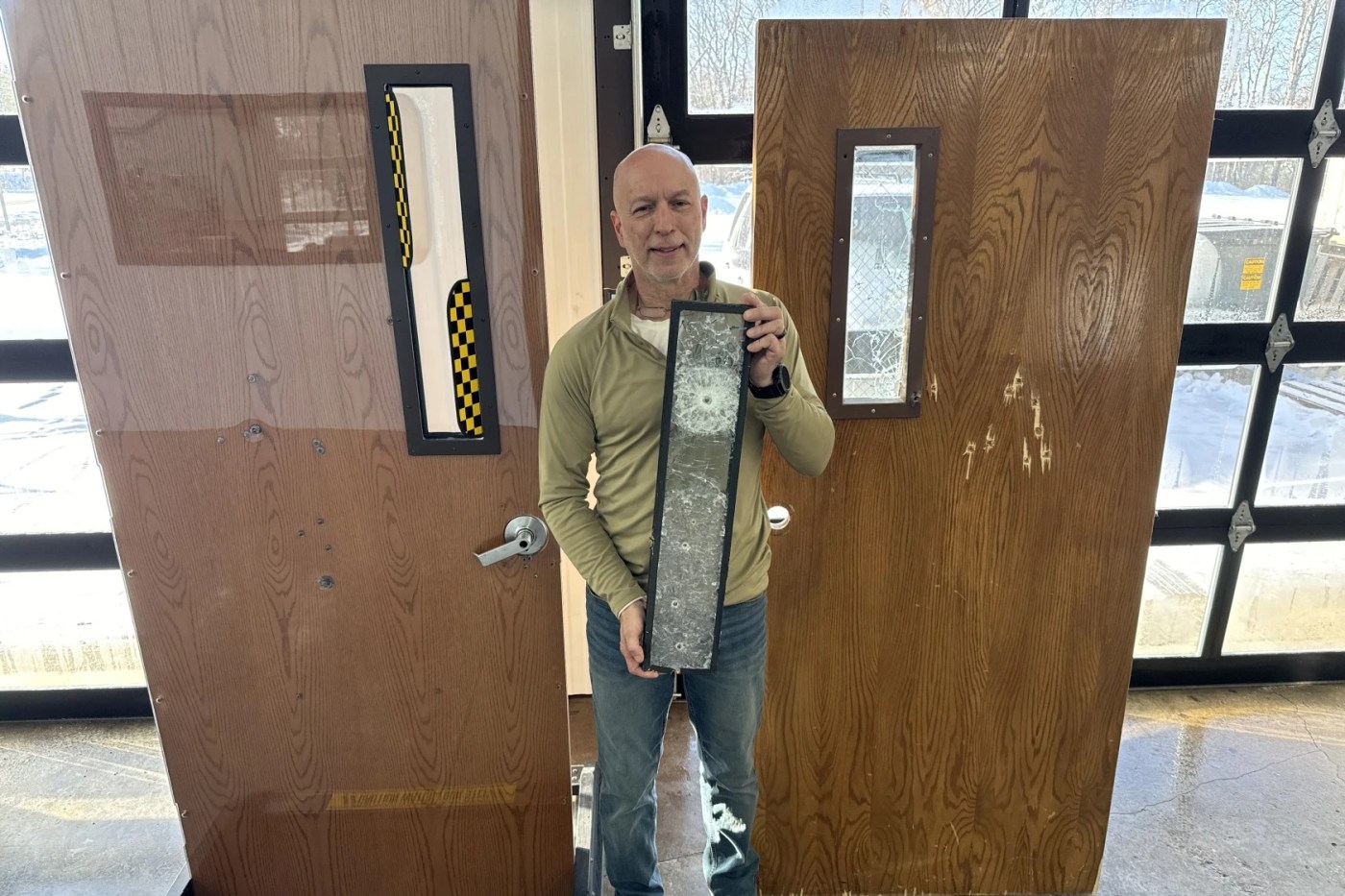
Minnesota business develops bullet-resistant door technology
PINE RIVER, Minn. — In a time when school violence is far too common in national headlines, a business is working to make reinforcements for classroom doors.
Pine River has been home to a company specializing in ballistic glass since 2021. The company manufactures reinforced window panels to protect machine operators from mishaps with fast-spinning equipment.
Not that long after opening up shop, Ballistic Vision Safety Glass owner Raymond LeFavor and his brother, Rich LeFavor, started working on another, more public safety-minded product.
They began developing window and door kits to reinforce existing school doors and windows to withstand an attempted active shooter.
Zero Breach, Raymond LeFavor’s new product line, so far consists of three main parts: polycarbonate reinforcement for wooden classroom doors, mirrors that allow a clear view of the hallways outside of a room, and windows designed to stay intact under fire from a weapon.
There are some ballistic-resistant doors available already; however, LeFavor said the cost of existing, basic doors that comply with strict building codes is already as much as $1,800-$2,000, or upward of $5,000 for reinforced models.
Disposing of the already expensive doors only to replace them with even more expensive doors seemed cost-prohibitive to him.
“Instead of reinventing the wheel,” LeFavor said, “why not just give it better hubcaps?”
LeFavor’s product would fit over existing doors with tight clearance around windows and hinges at a price tag of around $1,000.
The half-inch polycarbonate outer cover is designed to slow bullets and help a door maintain its composure even under fire from weapons, instead of splitting along grains and risking the integrity of lock plates, hinges and other weak points.
Next, he addressed the windows, which he said are too easy to break.
“That’s how they gained entrance in the Nashville shooting,” LeFavor said, referring to a mass school shooting there last March.
For that reason, LeFavor designed replacement window inserts inspired by windows in military transport vehicles. Those vehicles are often equipped with 2-inch thick, reinforced windows.
LeFavor designed a 1 ¾-inch window with a combination of glass and polycarbonate that will not simply shatter on impact.
Using a scale to measure ballistics resistance, LeFavor said demonstrations have shown their window replacements to be resistant to a level seven forced entry, meaning it can withstand at least five shots from an AR-15 (.223 caliber round).
Based on the same scale, the door reinforcements rank at level six, or strong enough to withstand at least five 124-grain 9mm rounds.
“We’re working on a couple things to make doors a tad stronger,” LeFavor said.
LeFavor’s company has done its own testing, and in June the company invited representatives from the Pine River-Backus School District, Pine River Police Department and other groups to view a demonstration.
“It surpassed what I hoped it would do,” LeFavor said. “That surprised me when we really got down to it.”
In addition to the general resilience, LeFavor said he was surprised how much bullet fragments seemed to rebound off of his safety door, possibly even injuring a shooter who might be standing close due to narrow hallways.
Trained officers took turns testing the doors against various small arms, rifles and even a door-breaching shotgun round.
While the doors did sustain damage, the Zero Breach reinforcements proved effective, slowing rounds to the point that they were unable to exit the other side of the door and window glass.
The breaching round, for example, bulged the back of the door without exiting. Compared to a traditional door, the tests were promising.
“It was very impressive,” said Pine River-Backus Superintendent Jon Clark.
Developments have continued since that demonstration. Having professionals from law enforcement and the school present raised questions regarding weather resistance in outdoor applications, the impact of the added weight on door hinges, long-term resilience around students and how the door reinforcements might impact fire ratings for some doors.
“There is some testing we need to see,” Clark said. “This was a summer demonstration, but how does it hold up in extreme cold temperatures or humidity?”
The school is in talks to assist with testing the doors in a smaller capacity. The school board will need to discuss more before any decisions are made.
LeFavor is also working with other groups. He expects products to be available in March or April at the earliest. He is chomping at the bit to see the doors go into use, even to the point of pledging some of his own money to donate doors.
LeFavor has personal motivation to make the average educational experience more secure. His wife, Rachel, is Pine River-Backus’ director of teaching and learning.
“My wife is on the frontlines,” LeFavor said. “I couldn’t live with myself if something happened. She’s married to someone who specialized in this for the last 25 years. It would be a horrific irony.”
LeFavor said his main goal with Zero Breach doors is to buy time. In a worst-case scenario, he wants students and school employees to have the best chance of staying safe until help arrives.
He even sometimes feels bad that his idea didn’t come in time for other schools in the nation; but locally, his efforts have not gone unnoticed.
“Entrepreneurs right here in Pine River have school safety in mind,” Clark said. “They are trying to look and see what they can do to help and make a difference, and I think that’s kind of amazing.”
Related Articles
‘Tom the Lost Trucker Cat’ found in Sauk Rapids after disappearing 40 days ago in St. Cloud
Minnesota 2023 deer harvest down statewide from 2022, DNR says
Canadian company eyes Minn. titanium, copper-nickel projects
Minnesota revenue forecast shows $3.7B surplus, but shortfall still projected for 2026-2027
Widow of fallen Burnsville officer Paul Elmstrand recalls their sweet life together


